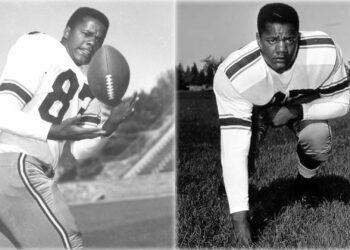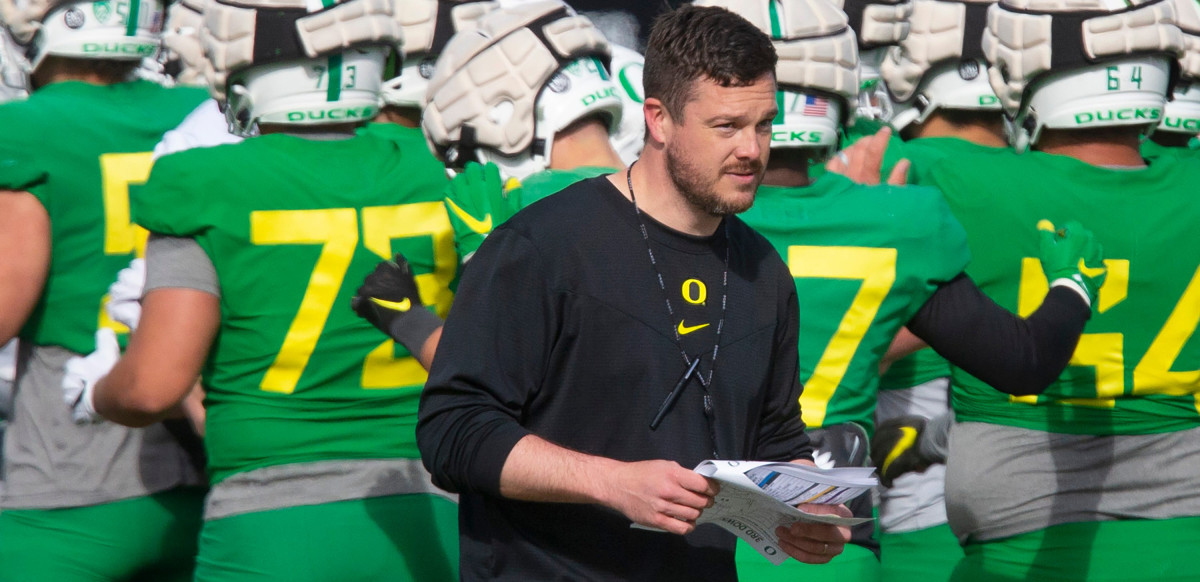By Bill Carroll
The 2023 Pac-12, is perhaps, one of the most wryly humorous names that I have seen since, Sue Yoo, attorney at law, or Ditcher, Quick, and Hyde, divorce lawyers. Speaking of divorces, having previously lost twin conference pillars USC, a member since 1922, and, crosstown rival, UCLA, a part of the conference since joining, in 1928. The 2023 Pac-12 is now going through the sports equivalent of dividing assets and figuring out visitation rights.
Also, now joining USC and UCLA in flight from the 2023 Pac-12: Arizona’s Wildcats, The Sun Devils of Arizona State the Oregon Ducks, and Washington Huskies, all of whom, were among the founding members of the Pacific Coast Conference in 1916.
Arizona and Arizona State came to the Pac-8 in 1978, henceforth known as the Pac-10. The University of Colorado accepted its invitation to join the Pac-12 on June 11, 2010, and on June 17, 2010, the University of Utah agreed to join the Conference.
The 2023 Pac-12 is in crisis, while the conference had, an amazing multi-sports peak, exemplified by the era of the quotable, USC head coach, John McKay (1960–1975). In those years USC had two Heisman Trophy winners (Mike Garrett and O. J. Simpson) won four national championships (1962, 1967, 1972, and 1974), and had several great baseball players like, Don Buford, Steve Busby, Dave Kingman, Tom House, Fred Lynn and Tom Seaver in that period.

UCLA dominated college basketball in a way that has not been seen before, or since. The “Wizard of Westwood”, John Wooden won 10 NCAA Men’s Basketball Championships: 1964, 1965, 1967, 1968, 1969, 1970, 1971, 1972, 1973, 1975. In that time he set unreachable marks for success: Seven NCAA championships in consecutive years: 1967, 1968, 1969, 1970, 1971, 1972, 1973. He had the most appearances in the Final Four, 16; the most consecutive appearances, nine; and most victories, 21. His career 40 season winning percentage .813 (Dayton High School, South Bend Central High School, Indiana State Teachers College and UCLA).
At Arizona Robert Luther “Lute” Olson 1983–2007 turned the Wildcats into a top tier team, winning the 1997 NCAA championship. Around that time Richard Hastings “Dick” Tomey 1987–2000, turned the “Desert Swarm” defense into a path to two of the three ten-win seasons in school history and posted 95 wins as the coach. While at Arizona State from 1958-1979 Frank Joseph Kush in football built one of the NCAA’s toughest teams. His militaristic style was brutal but effective and he went 176–54–1.
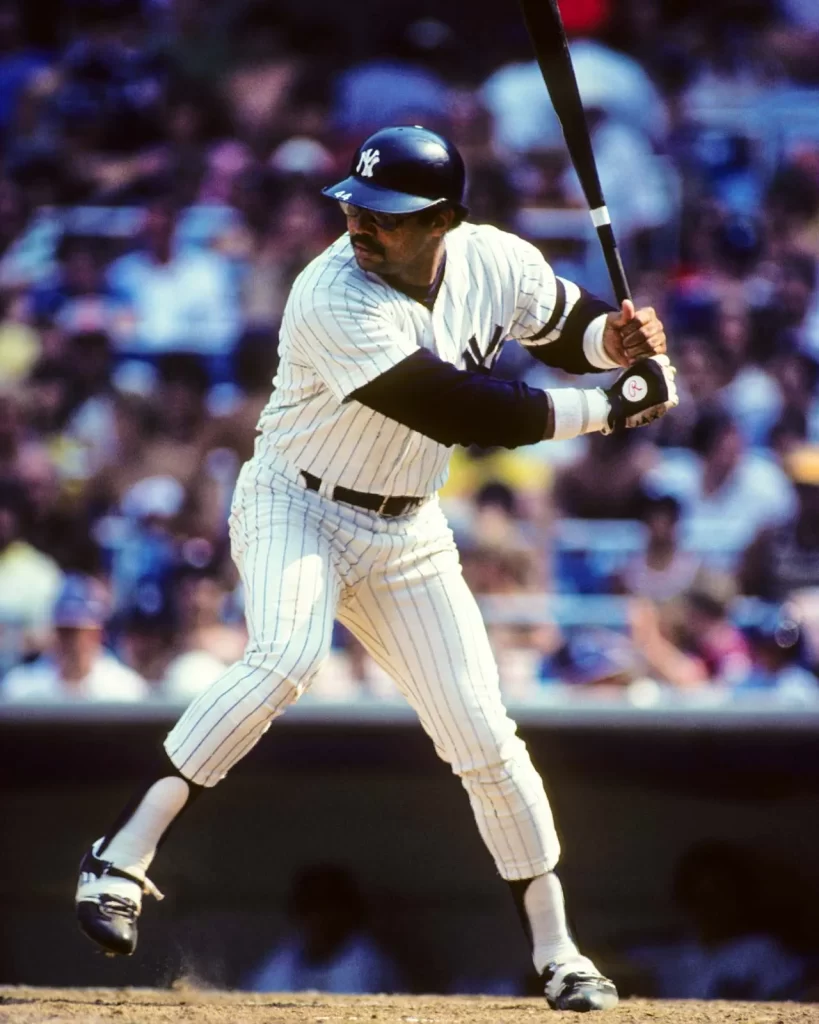 |
||
A side-note, Baseball Hall of Famer Reggie Jackson played a year of football at Arizona State for Kush on a football scholarship before switching to baseball. After this was happening, Washington State had good run under Dennis Brian Erickson who turned around a losing program to 9-3, in his second season on the Palouse. He was followed by his high school teammate, Michael Bruce “Mike” Price taking over 1989–2002 and helping develop Drew Bledsoe, Ryan Leaf and Jason Gesser with a 83–78 (.516) record, with three ten-win seasons and five bowl appearances.
At Washington, Don James built a winning Huskies program, up to winning a consensus national championship in 1991. Between 1975 and 1992, James’ teams won four Rose Bowls, the Orange Bowl in January 1985, and had a 10–4 record in all bowl games. Overall, James record at Washington was 153–57–2 (.726) . During his tenure they had one losing season at 5-6.
This peak continued when USC was playing for national championships in the early 2000s, when Oregon’s sartorial splendor and Chip Kelly’s uptempo, no-huddle offense helped Marcus Ardel Taulauniu Mariota to win a Heisman Trophy and was influencing programs nationwide. Cal football had Aaron Charles Rodgers, Stanford was competitive and very good, with a special QB, Andrew Austen Luck to Utah, in the Utes rather short stay, they made a mark on the Pac-12. Kyle Whittingham replaced Urban Meyer in 2005 and was there June 17, 2010, when the Utes joined the Pac-12, formerly the Pac-10.
With the exception of back to back 5-7 seasons in 2012 and 2013, the Utes have had wining seasons in their Pac-12 years. In 2021 and 2022 they topped USC in the Pac-12 conference championship game.
The 2023 Pac-12: The Present
“Once USC and UCLA went to the Big Ten (last year), I knew this was all going to happen,” former Big East Commissioner Mike Tranghese said. “We now have total chaos.”
Washington State, head football coach, Jake Dickert. did not mince words, just this past Thursday:
“I mean, not a single player has asked me one time about it. We gotta control what we can control,” “It’s amazing to me. … The old question — how long would it take TV money to destroy college football? Maybe we’re here. Maybe we’re here. To think even remotely, five years ago, the Pac-12 would be in this position, it’s unthinkable to think that we’re here today.
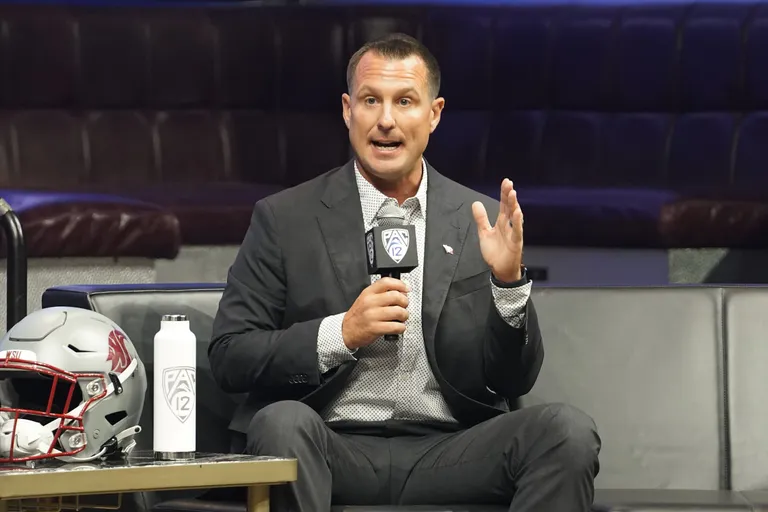
Speaking of money, the reason most of this is happening is the money, or lack thereof coming via the TV deal for The 2023 Pac-12, primarily for college football. Apple TV does not provide linear AKA traditional television delivered via satellite or cable, and all but one game weekly, from the 2023 Pac-12 would be behind a paywall. So that sounds starkly different from what some were expecting and even touting.
“We were offered a media contract by the Apple corporation, which was a technological 23rd century Star Trek-thing with really unbelievable capability that we very interested in,” Arizona State President Michael Crow told reporters over the weekend.
According to The Athletic, 2023 Pac-12 commissioner George Kliavkoff presented an offer to school presidents and athletic directors on August 1, 2023, that would pay member schools an estimated base of $23 million a year for five seasons with increases for subscriptions to a Pac-12 athletics package on the Apple TV streaming service.
Kliavkoff said, in an interview during The 2023 Pac-12 Football Media Day, [attention Freezing Cold Takes: @OldTakesExposed] which may end up filed under, “Famous Last Words”:
“Our schools are committed to each other and to the Pac-12,” Kliavkoff said. “We’ll get our media rights deal done, we’ll announce the deal. I think the realignment that’s going on in college athletics will come to an end for this cycle.
“The truth is we’ve got bigger fish to fry. There are incredible opportunities and also challenges in front of college athletics, and I need to be able to work with all of my colleagues in Division I and particularly in the A5, and we’ll do that. We’ll move past all the bitter squabbling of the last year, and we’ll work together to make college athletics better.”
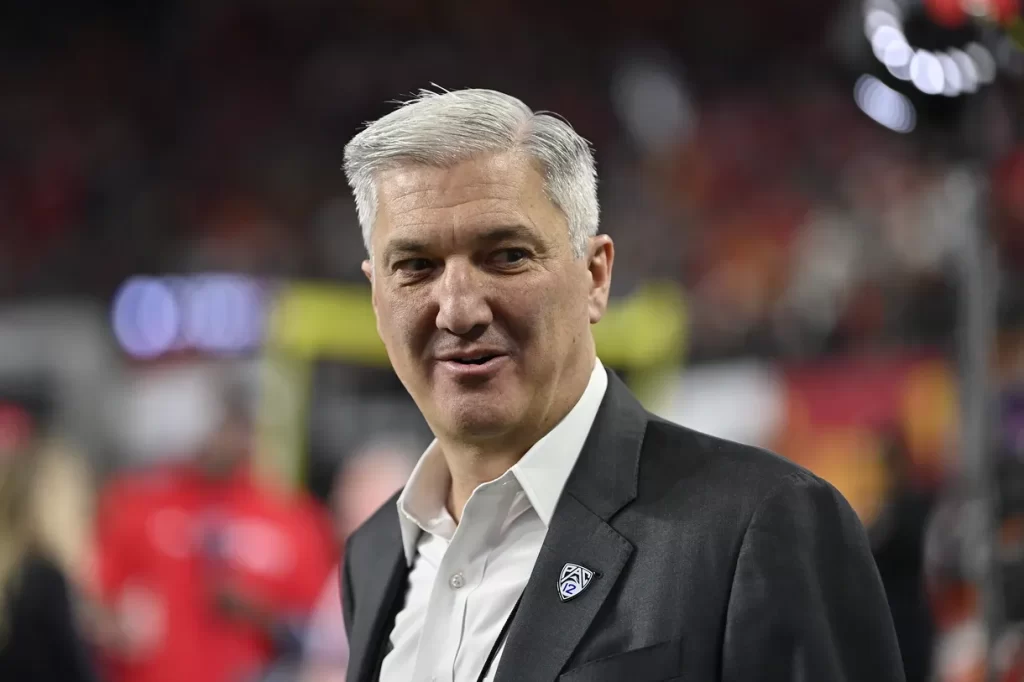
Former commissioner Larry Scott had envisioned a conference with 16 members as far back as when Colorado joined, in 2010. Negotiations for the conference’s current broadcast deal with ESPN and Fox, a 12-year $3 billion deal was once the “Rolls Royce” of conference TV deals. However he tried and failed to expand to conference’s cultural and geographical footprint.

The 2023 Pac-12 is not simply a victim of the fickle finger of fate and inept leadership. There have been repeated harbingers of what was to come. On May 13, 2021, Kliavkoff was announced as the Pac-12 commissioner. When the Big 12 lost Oklahoma and Texas, they still recovered with a deal for their remaining members, this is part of why Colorado ended a 2010-2023 layover in the Pac-12, boarding for a return trip to the Big 12.
The 2023 Pac-12: The Past
As was alluded to previously, the 108-year-old Pacific 8/10/12 Conference was an offshoot of the Pacific Coast Conference. Established, December 2, 1915, the first official Pacific Coast Conference event was a track meet was held with California, Oregon, Oregon State, Stanford, Washington and Washington State. That meet continued uninterrupted through 1928.
Idaho joined the Pacific Conference in early 1922. USC joined the PCC in the fall of 1922, in 1924, the PCC welcomed the Montana Grizzlies. In 1928, the PCC grew to 10 members with the addition of UCLA. Montana left for the Skyline conference, in 1950. The PCC was largely dependent on the state of California for top recruits and this showed when UCLA became dominant in football, with 34-5 record from 1952-55.
In the 1940s and 1950s, the Pacific Coast Conference and the Big Ten were informally, supportive of each other. Beginning in 1946, they contracted with The Rose Bowl for a team from each conference to play. The Rose Bowl, became the “Granddaddy of them all” as two conferences, also worked together within the NCAA. They generally voting together, including advocating for more faculty control of college sports, to protect the true “amateur model”, while rejecting athletic scholarships and recruiting.
The Pacific Coast Conference and the Big Ten schools tended to favor NCAA regulatory powers that were robust, as well as the 1948 Sanity Code, which sanctioned awarding scholarships and jobs, with a caveat that the recipients had to demonstrate financial need, while banning off-campus, or alumni boosters from recruiting, demanding that admissions requirements for students and student-athletes be the same and limiting the amount, source and type of financial aid colleges awarded.
The Southern Conference and The Big Eight opposed the Sanity Code. Later, in 1956, the NCAA sanctioned the awarding of scholarships without regard to an athlete’s academic or economic standing.
On June 30, 1959, the Pacific Coast Conference was dissolved. UCLA, and Washington formed the Athletic Association of Western Universities (AAWU). The AAWU did not initially make an agreement with the Pasadena Tournament of Roses Association to participate in the Rose Bowl Game until the following year, thoogh the Tournament of Roses did choose to invite the AAWU‘s inaugural regular season champion to the first post-PCC Rose Bowl.
In the following years, Washington State in 1962, Oregon and Oregon State in 1964 were added, but were initially denied admission. Going back to the late stages in the PCC, UCLA and Stanford had been at loggerheads, as Stanford had voted for UCLA’s expulsion from the conference.
Idaho was untouched by scandal, but was not able to attract enough talent to compete in the PCC. Washington State, Oregon, and Oregon State, all pursued membership, Idaho did not. The Vandals competed as an independent before jioning the Big Sky Conference, as a charter member in 1963.
The AAWU eventually consolidated itself as a conference, adding members Washington State, joining the new conference in 1962 and Oregon and Oregon State in 1964, while renaming itself the Pacific-8 Conference (Pac-8) in 1968. In 1978 Arizona and Arizona State left the WAC for the PAC-8, soon it was renamed the Pac-10.
“So much of sports fandom is about identity, and this takes an anchor away,” my colleague Billy Witz, who covers college sports for The New York Times, told me. “The Pac-12 was, for better or worse, the identity of West Coast athletics.”
The 2023 Pac-12: The Future
Washington State AD Pat Chun summarizing the plight of the Pac-12: “This league has been grossly mismanaged for over a decade.”
— John Canzano (@johncanzanobft) August 9, 2023
WSU AD Pat Chun on mood around campus:
“Handling the stages of grief. This is an institution and athletic program that’s incredibly proud…but the reality is Cougs are tough and we’ll come out swinging. This thing is far from over. WSU will continue to be a national brand.”— Alyssa Charlston (@Alyssacharlston) August 9, 2023
The 2023 Pac-12’s death spiral as a conference was, partially, set in motion when the Pac-12 refused to award additional revenue shares to the USC Trojans. It is very likely that, if they had received the added funds, they would have remained not only conference member of the 2023 Pac-12 but beyond. The 2023 Pac-12 conference is in a struggle for its very survival, largely due to USC having been disgruntled.
When George Kliavkoff replaced Larry Scott in 2021, he was unable to address and resolve that festering issue. USC left just one year after Kliavkoff was named commissioner. John Ourand of Sports Business Journal reported that in 2022 the Pac-12 presidents reportedly rejected an ESPN deal which would have paid each member school $30 million per year.
George Kliavkoff visited Dallas to meet with SMU, earlier this year, also Boise State and San Diego State each considered, but refused, entreaties to join the 2023 Pac-12. In the 2024-25 academic year, the Big 12 Conference will consist of 16 members Arizona, Arizona State, Baylor, BYU, UCF, Cincinnati, Colorado, Houston, Iowa State, Kansas, Kansas State, Oklahoma State, TCU, Texas Tech, Utah and West Virginia.
From Bear Insider writer, Greg Richardson
Only five short years ago, Stanford was a national power in football with regular appearances in the Rose Bowl. Less than fifteen years ago, Jeff Tedford led Cal to a seven-year run of national prominence as the clear 2nd best program in the Pac-10 behind only Pete Carrol’s storied USC program. And most importantly, Cal’s TV ratings and game attendance during that period were top-tier by any relative measure.
Despite all of those being cogent points, the loss of access to the Los Angeles, Phoenix are and Seattle markets means that Mountain West is currently a more attractive television product than is the 2023 Pac-12. It is likely for that reason that Boise State and San Diego State demurred when the 2023 Pac-12 came to court them.
The overarching question is, can Stanford and Cal work together with Washington State and Oregon State to reform the Pac-? through poaching top programs from the American Athletic and Mountain West conferences? Could Fresno State, Nevada, San Jose State, UNLV Fresno State president Saúl Jiménez-Sandoval has been in contact with the Big 12 Conference and the 2023 Pac-12.
The 2023 Pac-12 may also target Colorado State and/or the Air Force Academy. Either one would bring the 023 Pac-12 back into the Rocky Mountain market. Texas may even be a possibility if Rice, SMU or even Texas State is willing to listen. Ironically, just over a year ago the conference attempted to extract from ESPN $50 million per school. ESPN politely declined and retracted their previous offer of around $50 million per school.
Washington State AD Pat Chun: “There’s a century of history that has gone by the wayside because this conference has mismanaged itself on a bunch of different levels. And when you have poor leadership, one of the outcomes is failure. That’s what has happened to the Pac-12.”
— Greg Woods (@GregWWoods) August 9, 2023
Now with less than half of that, even possibly available, the 2023 Pac-12 will likely need a chess Muzio Gambit or in poke terms they will need to draw to an inside straight, if they are to make it from being the 2023 Pac-12 to become the 2024 Pac-12.


 NFL
NFL
